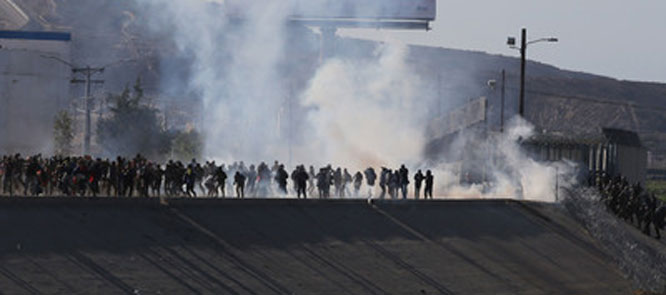
Alarming new numbers about border apprehensions from U.S. Customs and Border Protection should puncture the lazy conventional wisdom about the border being under control, except in the lurid imagination of President Donald Trump.
All during the fight over a border wall, we were told by the media and progressives commentators that the border is practically locked down because apprehensions are down from highs in the 2000s. Along with almost every other critic of the president, Steve Schmidt was outraged that "the president of the United States would manufacture out of whole cloth this crisis."
Being anti-Trump means never having to say you are sorry or you were wrong, so the latest evidence won't make an impression on anyone who blithely dismissed the idea of border crisis. But it should.
More than 76,000 migrants were apprehended crossing the southern border last month, the highest February in more than 10 years and the highest month of the Trump administration. The number of apprehensions tops any month during the 2014 border surge under President Barack Obama, which no one had a problem calling a crisis at the time.
Every indication is that the situation is going to get worse. We could be about to experience a migrant surge worthy of Angela Merkel at her most open-handed, even though, in immigration terms, Viktor Orbán—the Hungarian prime minister who favors tough border enforcement—is president.
The commentary and fact-checks about there being no crisis have missed, or deliberately ignored, the changing nature of border apprehensions.
Yes, there were more overall apprehensions in the 2000s. But it was a different population, made up overwhelmingly of adult males from Mexico who might be apprehended trying to cross multiple times and were reliably returned home when they were caught. Now, we are apprehending people but not returning them.
Migrants are coming in greater numbers from Central American countries instead of Mexico, and are primarily families and children. In an astonishing shift, in 2012, 10 percent of apprehended migrants were families and children; in recent months, it's been 61 percent.
The rules for dealing with migrants from noncontiguous countries and with family units make it all but impossible to swiftly return or detain them, not to mention that our physical facilities were built with single adults in mind.
There is no mechanism to return these migrants home, to hold them after they cross the border, or to remove them once they are in the interior. And word has gotten out. There's a reason that the subset of migrants that we can't stop from getting into the country is rapidly growing.
The trend is for these migrants to come by bus, reducing the trek to days, and to travel in large groups. In recent months, 70 groups larger than a hundred showed up. There were just 13 such groups the year before, and two the year before that. They simply turn themselves in because they know they will make it into the country.
The system is overloaded. According to The New York Times, a group housing immigrants in El Paso, Texas, had 3,600 migrants released to its care in one week in February, the most in one week since the group started more than 40 years ago.
Once they arrive, the migrants are unlikely to be made to leave. ICE has limited resources and more urgent priorities, even if the necessary detention space existed.
Needless to say, a spiraling border crisis is maddening for a president committed to controlling the border, which is why we've seen such frenetic activity from Trump.
He's tried to prosecute all adults crossing the border illegally, and had to abandon it in the (understandable) firestorm over the resulting family separations. He's tried to jawbone Mexico into helping, with some success, although migrants are still traveling through Mexico in large numbers. He's tried to tighten up asylum policy, but been blocked in the courts. He's tried to get Congress to fix the rules for dealing with migrants, to no avail. And, of course, he's tried to build a wall.
Trump's rhetoric may be over the top and his focus on the wall too monomaniacal, but the impulse to get a handle on this is absolutely correct.
First, there's the question of basic sovereignty. If we are going to welcome a large number of migrants—and over time perhaps a significant portion of the population—from three or four foreign countries, we should make that decision as a conscious policy, rather than slip-sliding into it unawares.
Then, there's the matter of assimilation and legality. Poorly educated immigrants, like the ones coming from Central America, have the hardest time assimilating, and they will lack legal status on top of it. We are adding the next tranche of so-called Dreamers who will require yet another amnesty.
Finally, there's the humanitarian question. Migrant families show up needing medical attention that we aren't well-prepared to provide. We'd be much better positioned to tend to the migrants under our care, and focus on the needs of the relatively small number of legitimate asylum seekers, if the numbers weren't overwhelming.
But we are at a stalemate. The Times editorialized the other day that Trump declared "that there's a crisis at the border, contrary to all evidence." Then, the paper ran a news story headlined, "Border at ‘Breaking Point' as More than 76,000 Migrants Cross in a Month."
Both of those pieces can't be right. There's manufacturing a crisis, then there's ignoring one for fear of conceding anything to Trump.
Sign up for the daily JWR update. It's free. Just click here.
(COMMENT, BELOW)


 Contact The Editor
Contact The Editor
 Articles By This Author
Articles By This Author